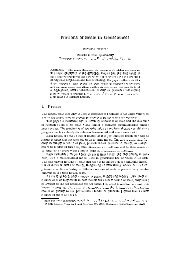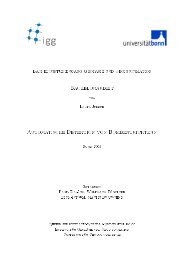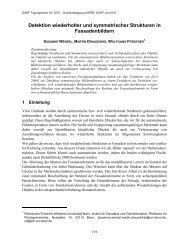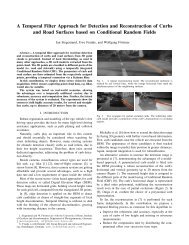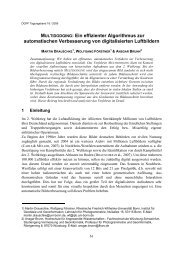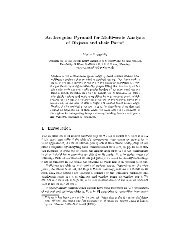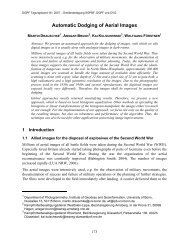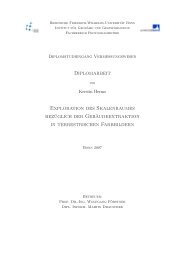Mapping on Demand - A Dream
Mapping on Demand - A Dream
Mapping on Demand - A Dream
You also want an ePaper? Increase the reach of your titles
YUMPU automatically turns print PDFs into web optimized ePapers that Google loves.
<str<strong>on</strong>g>Mapping</str<strong>on</strong>g> <strong>on</strong> <strong>Demand</strong> - A <strong>Dream</strong><br />
Wolfgang Förstner<br />
Autumn 2002<br />
1 Goal<br />
1.1 Motivati<strong>on</strong><br />
Classical maps are used for decisi<strong>on</strong> making. They have been graphical representati<strong>on</strong>s of the earths<br />
topography or of some specific theme mainly using symbols. Their producti<strong>on</strong> took several decades,<br />
updating was d<strong>on</strong>e locally. Their producti<strong>on</strong> was motivated by military purposes. Users were trained<br />
to read the maps.<br />
Yesterdays maps are graphical representati<strong>on</strong>s of the c<strong>on</strong>tent of a Geoinformati<strong>on</strong> System (GIS)<br />
either <strong>on</strong> paper or digital displays. Photogrammetry enabled to manually produce and update maps<br />
within a few years. Maps became multi-purpose maps, serving a variety of users within society.<br />
Todays maps are visual representati<strong>on</strong>s of the c<strong>on</strong>tent of GIS integrating annotated images and<br />
videos. Remote sensing and semiautomated photogrammetric techniques allow to produce and update<br />
maps within a few m<strong>on</strong>ths. Visualizati<strong>on</strong> of processes can be based <strong>on</strong> powerful simulati<strong>on</strong> and<br />
computer graphics tools and be produced in hours or days and still require skilled users.<br />
As many planning processes took weeks, m<strong>on</strong>ths or even years, real time requirements could be<br />
fulfilled with current technologies, c<strong>on</strong>taining <strong>on</strong>ly little automati<strong>on</strong>.<br />
1.2 The <strong>Dream</strong><br />
Tomorrows maps are audio-visual representati<strong>on</strong>s integrating annotated images, video, speech, sound.<br />
They are used for disaster management, for vehicle c<strong>on</strong>trol, for guidance of tourist with an intelligent<br />
pers<strong>on</strong>al digital assistant, for geo-scientists and others.<br />
They need to be generated <strong>on</strong> the fly depending <strong>on</strong> the specificati<strong>on</strong>s of an unexperienced user and<br />
possibly need to transparently transfer the desired informati<strong>on</strong> by audio and video to the user.<br />
They have access to various modes of available data: Existing maps, especially all pre-interpreted<br />
informati<strong>on</strong> already c<strong>on</strong>tained in Geoinformati<strong>on</strong> Systems, but also intensity-, color-, range-, -images,<br />
image sequences, possibly in corresp<strong>on</strong>ding data bases or distributed in the Internet. In all cases it<br />
will be useful to go bey<strong>on</strong>d pre-interpreted data and make all hidden informati<strong>on</strong> avaliable.<br />
1.3 Embodiment<br />
The generati<strong>on</strong> and use of maps always were embodied into a decisi<strong>on</strong> making process referring to<br />
some spatial regi<strong>on</strong> within a certain time frame. The c<strong>on</strong>trol loop always c<strong>on</strong>tained humans, who<br />
specified the purpose of the maps, who specified the legend the map, who generated the map and used<br />
the map, often as an interactive planning medium.<br />
In c<strong>on</strong>trast to seeing machines, where the c<strong>on</strong>trol loop between the visual system and the actors<br />
might we very short, the embodiment of the specificati<strong>on</strong>, the generati<strong>on</strong> and the use of maps needs<br />
to model the human as actor to such an extent, that the automatic generati<strong>on</strong> and presentati<strong>on</strong> of<br />
informati<strong>on</strong> is adapted to the human cognitive abilities, obviously depending <strong>on</strong> the training of the<br />
user.<br />
Though this might reduce the speed requirements in terms of reacti<strong>on</strong> times, the problems to be<br />
solved are similar to visually guided machines. On the c<strong>on</strong>trary, due to the possibly l<strong>on</strong>ger resp<strong>on</strong>se<br />
times fusi<strong>on</strong> of data of various modes becomes necessary, increasing the complexity of the models for<br />
problem solving.<br />
1
1.4 Technological and Scientific Situati<strong>on</strong><br />
The foci of future maps are, current car navigati<strong>on</strong> systems already c<strong>on</strong>taining some of these features:<br />
1. limited transmissi<strong>on</strong> rate<br />
This will <strong>on</strong>ly gradually change in future. It may overcome in case of high-level coding of the<br />
semantics, requiring a cognitive approach<br />
2. limited display resoluti<strong>on</strong><br />
This will certainly be overcome in the next decade<br />
3. multi-medial output (images, video, sound, audio)<br />
Technology will allow any type of integrated presentati<strong>on</strong> in the future. The main problem is<br />
the transfer from informati<strong>on</strong> to audio-visual output such that the human percepti<strong>on</strong> deviates<br />
minimally from the desired intenti<strong>on</strong>.<br />
4. untrained users for specificati<strong>on</strong> and reading of maps.<br />
There are two steps where cognitive abilities of the user need to be modeled:<br />
(a) the specificati<strong>on</strong> of the desired output<br />
A natural language interface would be desirable. In the most simple case the user could<br />
select from a set of pre-specified opti<strong>on</strong>s. In a far more advance case the user would<br />
specify his intenti<strong>on</strong>s, which then would be transferred into requirements for the desired<br />
informati<strong>on</strong> and mode of presentati<strong>on</strong> needed.<br />
(b) the generati<strong>on</strong> of the audio-visual output<br />
In c<strong>on</strong>trast to the cogniti<strong>on</strong> of natural scenes, the human visual system is optimized for, we<br />
have to model the ability of the human visual system with respect to artificial visual stimuli.<br />
Especially the visualizati<strong>on</strong> of n<strong>on</strong>-visual informati<strong>on</strong>, usually realized by symbolizati<strong>on</strong>,<br />
needs to be modeled.<br />
5. short resp<strong>on</strong>se times, down to a few sec<strong>on</strong>ds.<br />
In case of pre-interpreted informati<strong>on</strong> this is state of the art.<br />
6. integrati<strong>on</strong> of un-interpreted image data<br />
This is probably the most challenging problem and central for the cognitive visi<strong>on</strong> part of the<br />
dream.<br />
2 Scientific Issues<br />
2.1 C<strong>on</strong>text modeling<br />
There are several places where modeling c<strong>on</strong>text is a central issue:<br />
• the c<strong>on</strong>text in existing maps (GIS or other spatial data bases) is both:<br />
– related to the legend, i. e. to the data model (in data base terms)<br />
– related to the spatial neighborhood, e. g. when identifying a road crossing in a large scale<br />
map, where road crossings are no basic entity<br />
• the c<strong>on</strong>text of image related partial interpretati<strong>on</strong>s similarly requires the world and image model<br />
for interpretati<strong>on</strong> together with the spatial neighborhood relati<strong>on</strong>s.<br />
• the specific task defines the c<strong>on</strong>text for the informati<strong>on</strong> fusi<strong>on</strong> process.<br />
• the type of viewer influences the way the various c<strong>on</strong>texts, i. e. neighborhood relati<strong>on</strong>s between<br />
different spatially related facts is visualized.<br />
2
Main problems appear to be:<br />
• the definiti<strong>on</strong> or the learning or the c<strong>on</strong>texts<br />
• the adequate representati<strong>on</strong> of the c<strong>on</strong>texts<br />
• the efficient use of the c<strong>on</strong>text within the real-time task in c<strong>on</strong>cern<br />
• finding useful observables triggering c<strong>on</strong>trol based <strong>on</strong> c<strong>on</strong>text<br />
2.2 Spatio-temporal Multi-scale Representati<strong>on</strong><br />
One can assume that tera-byte of images are available, both terrestrial and aerial, both intensity and<br />
range. Spatio-temporal multi-scale representati<strong>on</strong> is a central issue. It appears at several places:<br />
• Terrestrial images show an extreme range of scales already within <strong>on</strong>e image<br />
• Aerial images occur in scales between 1:1000 to 1:10000, satellite imagery shows pixel sizes<br />
between 1 m and several hundreds, the scale however does not change too much within <strong>on</strong>e<br />
image.<br />
• image sequences c<strong>on</strong>tain events which are measured in sec<strong>on</strong>ds (crash), hours (rush hour) or<br />
even weeks (weather).<br />
Scale can refer to many modes:<br />
• numerical scales such as map or image scale, resoluti<strong>on</strong> or smoothing width referring to the<br />
geometrical or physical extensi<strong>on</strong> of objects.<br />
• <strong>on</strong>tological scales such as derivable from c<strong>on</strong>tainment or abstracti<strong>on</strong> hierarchies<br />
Main problems appear to be:<br />
• Finding adequate multi scale representati<strong>on</strong>s for spatial/temporal objects<br />
• understanding the relati<strong>on</strong> between numerical and <strong>on</strong>tological scales<br />
• Finding useful observables in data related to <strong>on</strong>e scale for objects having a different scale<br />
2.3 Adaptive C<strong>on</strong>trol<br />
Real time requests need efficient c<strong>on</strong>trol adapted to the available sources:<br />
• data (not all types of data will be available for every request)<br />
• models and algorithms (they evolve over time)<br />
• hardware (server and client; computer, screen, audio)<br />
• time (depending <strong>on</strong> internal speed of process to be served, navigati<strong>on</strong> of walking pers<strong>on</strong>s vs.<br />
driving pers<strong>on</strong>s vs. driving cars)<br />
Main problems of the request for this type of scalability appear to be:<br />
• An explicit model for meta data of available resources<br />
• transparent, theoretically founded performance characteristics of all algorithms for task planning<br />
3
2.4 Interactive Learning<br />
Models certainly will have to be learned. This may be d<strong>on</strong>e off-line training the system. This is a<br />
problem in its own. But it should use the knowledge of the users of the system, e. g. in case a specialist<br />
<strong>on</strong> modern architecture is using the system as tourist guide. It could be seen as a type of life-l<strong>on</strong>g<br />
learning. <str<strong>on</strong>g>Mapping</str<strong>on</strong>g> <strong>on</strong> demand gives an ideal situati<strong>on</strong> of mutual learning of humans and machines.<br />
Main problems appear to be:<br />
• The language for representing things to learn comm<strong>on</strong> to machine and human. This requires<br />
detailed modeling of human related specificati<strong>on</strong> languages.<br />
• A seamless communicati<strong>on</strong> between machine and n<strong>on</strong>-specialist. This requires detailed modeling<br />
of the human percepti<strong>on</strong> system w. r. t. seeing audio/visual annotated images or image<br />
sequences.<br />
2.5 Cue Identificati<strong>on</strong> and Integrati<strong>on</strong><br />
The multi-modality of the available data requires an adequate identificati<strong>on</strong> of cues for the various<br />
categories to be identified. This can be seen as finding observables. These are realized as image<br />
analysis algorithms (taking image as a category here) which either detect certain objects or estimate<br />
attributes of certain objects.<br />
Main problems appear to be:<br />
• Find cues as relati<strong>on</strong>s between observables, realized as algorithms, and partial interpretati<strong>on</strong>s.<br />
• Formally describe the value of the cues for initiating hypotheses. As the c<strong>on</strong>text of each of the<br />
different modes of data sources is different, homogenizati<strong>on</strong> of the representati<strong>on</strong> of the various<br />
cues appears to be crucial.<br />
2.6 Uncertainty Management<br />
All data and informati<strong>on</strong>s sources uncertain. This refers to:<br />
• The original data (statistical variati<strong>on</strong>s)<br />
• the models for evaluating the data (simplificati<strong>on</strong>s, bias, phenomenological models in place of<br />
physically based models, assumed relati<strong>on</strong>s, ...)<br />
• the specificati<strong>on</strong> (ambiguity of natural language, limitati<strong>on</strong>s of man-machine interface used for<br />
specificati<strong>on</strong>)<br />
• ambiguities in the percepti<strong>on</strong> of maps as annotated images or image sequences.<br />
• uncertainty about the performance of algorithms.<br />
Uncertainty management is a prerequisite for reliable predicti<strong>on</strong>s, for self-awareness of algorithms and<br />
for trustful visualizati<strong>on</strong>.<br />
Main problems appear to be:<br />
• Representati<strong>on</strong> of the various modes of uncertainty<br />
• Modeling the uncertainty of user defined specificati<strong>on</strong>s<br />
• Modeling the uncertainty propagati<strong>on</strong> through reas<strong>on</strong>ing chains with algorithms whose theory<br />
is understood <strong>on</strong>ly limited.<br />
• Visualizati<strong>on</strong> of automatically derived uncertain categories, together with their uncertain attributes<br />
such that the percepti<strong>on</strong> of an unexperienced user is correct.<br />
4



